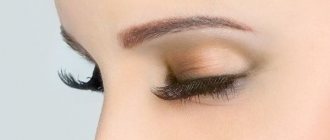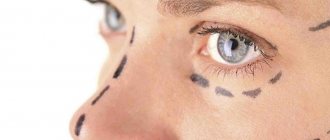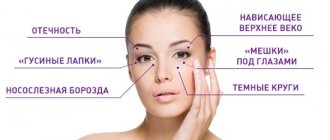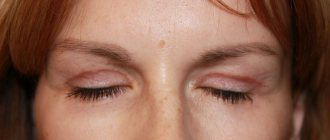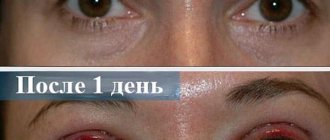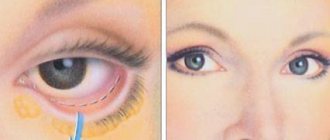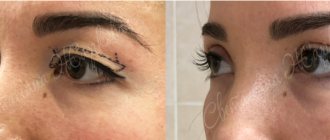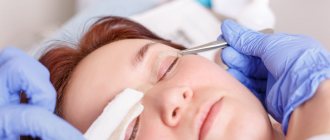It is very difficult to find a person who would be completely satisfied with his own appearance, especially for representatives of the fairer sex. True, today it is quite simple to change and correct defects - plastic surgery comes to the rescue. Operations related to eye correction are included in the list of the most common surgical interventions that are performed in specialized clinics. There are several types of such operations, one of which is called sangapuri, or Asian eyelid blepharoplasty. What is this procedure, how and where is it performed?
What is Sangapuri operation?
The features and traits of the human face are determined at the genetic level and largely depend on nationality. Representatives of eastern and western countries have significantly different eye shapes from each other - Asians do not have the characteristic fold on the upper eyelid, which is why the eyes look narrow and the skin seems to hang slightly over the top. This gives the face a tired and aged, and in some cases, gloomy appearance, which spoils the overall impression of the person’s appearance.
The Asian eye shape is a feature of the Mongoloid race. This is a narrow section of the palpebral fissure, smoothness or absence of supraorbital folds of the upper eyelid and the presence of epicanthus - skin folds in the inner corners of the eyes.
Asian eye shape has shallow orbits, thick eyelid skin, excess orbital fat and a higher brow position.
European eyes are considered the gold standard of beauty in the world - quite large, with long eyelashes and without excess tissue. For this reason, many people with Asian appearance dream of enlarging their eye shape and getting rid of drooping upper eyelids, for which surgery is used.
Hollywood cinema influenced the perception of appearance, and a fashion for European facial features gradually emerged in Asian countries.
Sangapuri is an operation to create a characteristic fold of skin on the upper eyelid and remove the epicanthus, another fold that is present at the inner corner of the eyes of Asians. This allows you to “open” your eyes, bring a person’s appearance type closer to a Caucasian one, and in some cases increase the field of vision and solve some problems associated with the functioning of the visual system.
The operation to Europeanize Asian eyes began in South Korea, from where the fashion spread throughout almost the entire Asian continent. The procedure is carried out in many Eastern countries (Thailand, Singapore, Kazakhstan, Uzbekistan, etc.), but South Korean doctors are considered real specialists in the correction of Asian eyelids. Examples of the best clinics where you can do this procedure are BTmedi and Arumdaun Nara, which are located in the capital of South Korea, Seoul, the approximate cost is $3,200.
Kinds
The operation can be performed in several ways, including surgical techniques that involve making an incision, as well as suture procedures that do not violate the integrity of the tissue.
- Formation of the upper eyelid fold and correction of the epicanthus. During this operation, the doctor creates a fold of skin on the upper eyelid, excises or completely removes the epicanthus, sometimes along with orbital fat and excess skin.
- Epicanthoplasty. The procedure involves excision, reduction or removal of the epicanthus.
- Eyelid lift. During surgery, miniature incisions are made on the skin of the upper eyelid, after which the intervention areas are stitched with a special thread. As a result, the eyelid rises, and the person develops a European fold.
- Eyelid surgery with incisions. To change the eyes, the doctor makes incisions along the edges of the upper eyelids near the edge of the eyelashes, as a result of which a scar is formed on the skin, which provides the necessary shape of the eyes.
Any method is combined with removal of the epicanthus, distribution of skin in the corner of the eye and lifting of the outer corners of the eyes.
For plastic surgery of Asian eyelids, experts have developed dozens of techniques, the choice of which is determined by the individual characteristics and wishes of the patient.
The method for performing Europeanization of Asian eyes depends on the characteristic features of the patient’s face and the result that needs to be obtained - for example, for people with thin skin of the eyelids, seamless methods of surgical intervention are recommended. The longest lasting effect (about 15 years) is achieved by plastic surgery with incisions, but it requires the surgeon to have certain experience and qualifications.
What is sangapuri
In many Eastern countries, Asian eyelid surgery has become a very common procedure. Asians explain this by saying that their faces are not as beautiful as those of Europeans. They undergo surgery to get closer to their ideal. Many Asian women desire to look more Westernized.
Changing the shape of the eyelids (sangapuri) in Korean means “eyes that do not have an epicanthus.”
The term originated and spread from South Korea, where plastic surgery is thriving. This operation, according to the classification, is classified as blepharoplasty (upper eyelid surgery).
Photos before and after Sangapuri
Concept
The epicanthus is considered an extension of the upper eyelid. It is a vertical fold of skin and fat located on the inner edge of the eye. This fold covers the lacrimal tubercle. A very developed epicanthus is the reason for the pronounced effect of slanting eyes.
Sangapuri is considered a type of blepharoplasty. The purpose of the operation is to create a second fold of the upper eyelid, increasing the shape of the eye in women of Asian appearance.
Kinds
Asian eye surgery is performed using two main methods:
- Formation of the supraorbital fold of the upper eyelid + correction of the epicanthus. In some cases, the epicanthus is completely cut out. Also, some other characteristics of a person of an ethnic nature may be subject to adjustment. When performing sangapuri, specialists can excise orbital fat and excess dermis.
- Experts often recommend canthoplasty. The essence of the operation is to lift the outer lateral parts of the eyes. After surgery, the eyes take on an interesting almond shape that resembles more Japanese features.
- Eyelid lift. This method of correcting Asian eyes is performed without incisions. It is used for patients with thin skin of the upper eyelid. Miniature punctures (about 1 mm) are made on the dermis of the eyelid, and the tissue is sutured using surgical thread. This creates a connection between the aponeurosis of the muscle that lifts the upper eyelid and the dermis, and the European fold is formed.
- Eyelid surgery with incisions, after which a scar is formed. In this case, the effect will be longer (up to 15 years). The surgeon makes an incision along the ciliary edge of the upper eyelid. It is this scar that forms the fold. The visual size of the new eye shape depends on the height of the incision (the higher the incision, the larger the eye). This Sangapuri method is a multi-step process. To carry it out, the surgeon initially excises the skin, then subcutaneous fat, and adjusts the muscles. Such an operation can only be entrusted to a practicing surgeon with extensive experience. The specialist must take into account the individual characteristics of the patient during the operation. This operation significantly increases the range of the visual field.
Indications
Quite often, eyelid surgery (sangapuri) is performed to help women achieve their ideal of beauty. Asian fashionistas find the large eyes and crease in the eyelid of Europeans very attractive. In addition, there are a number of conditions in which surgery is not pursued for aesthetic purposes, but for therapeutic ones.
A highly developed epicanthus can provoke the following unpleasant pathologies:
- lowering of the upper eyelid;
- difficulty in closing/opening the eyes;
- decreased field of view;
- difficulty in tear flow;
- turning the ciliary edge inward, which provokes regular damage to the cornea of the eyes.
Europeans usually do not have epicanthus, so cosmetologists can perform this operation mainly on Mongoloids and some representatives of the Australo-Negroid race. Only in rare cases does epicanthus appear among Europeans.
Atypical variants of the occurrence of epicanthus in representatives of the European race are:
- congenital diseases;
- scarring of the eyelids, which is caused by tissue injury;
- pathology in the development of the eyelids, transmitted genetically.
Sangapuri results
Contraindications
There are only a small number of contraindications for the operation. They are represented by the following states:
- dry eyes;
- increased intraocular pressure;
- diabetes;
- infectious diseases (stage of their exacerbation);
- conjunctivitis (its acute, chronic form);
- blood clotting disorder.
Comparison with similar techniques
Not every Asian woman can afford to have sangapuri, so Asian women began to use other techniques to transform their image. Specialists from Japan and Korea have come up with adhesive strips and special adhesives. Thanks to this simple device, every fashionista has the opportunity to form a semblance of a fold by slightly lifting the side part of the eyelashes.
A long-lasting, pronounced effect (formation of a fold on the upper eyelid) is provided only by sangapuri and other types of epicanthoplasty (Amon's operation, W-plasty, Z-plasty). The difference in the method of performing these operations is in making incisions to remove the epicanthus and form an artificial fold of the upper eyelid.
Indications
Most often, the operation is performed for cosmetic purposes - with the help of the operation, Asian men and women strive to improve their appearance and bring it closer to European standards. Sometimes surgery is performed to achieve a therapeutic effect - pronounced epicanthus can provoke the following diseases:
- difficulty closing and opening the eyes;
- drooping upper eyelid;
- narrowing of visual fields;
- difficulty in the outflow of tears;
- improper growth of eyelashes, due to which they begin to injure the cornea.
Representatives of the Caucasian race usually lack epicanthus, and its presence is in most cases associated with pathologies of the eyelids.
Types of blepharoplasty in Singapore
Most plastic surgeons use the following methods when correcting Asian eye shape:
- No cut . During the correction, invisible sutures will be placed inside the eyelid, in their place a connecting fold will be formed, allowing the creation of a supraorbital fold. This correction is suitable only if there is slight drooping of the upper eyelids. This type of blepharoplasty is considered easy, the rehabilitation period is short, and there are practically no complications;
- With a cut . During this type of surgery, the plastic surgeon makes incisions with a scalpel on the upper eyelid and excises fat deposits and excess skin, creating a crease. This type of eye shape correction helps create a clear effect. However, it is fraught with unpleasant consequences, and rehabilitation takes longer than described above.
Restrictions and contraindications
Contraindications to the procedure include:
- dry eye syndrome;
- increased intraocular pressure;
- inflammatory eye diseases (blepharitis, conjunctivitis, etc.);
- blood clotting disorders;
- diabetes;
- tumor processes;
- blepharospasm;
- bronchial asthma;
- cardiovascular disorders;
- infectious diseases, chronic pathologies in the acute stage.
In addition, the operation is not recommended under the age of 16 years, during pregnancy and breastfeeding.
Contraindications
Eyelid correction is not considered the most difficult type of surgery, but it is still a full-fledged operation. Therefore, plastic surgery has a number of contraindications. Basically, these are typical contraindications for all surgical interventions:
- diabetes,
- disorders of the thyroid gland,
- acute stage of chronic disease,
- presence of infection or inflammation,
- cardiovascular diseases,
- bleeding disorder,
- oncology.
The operation is also not performed on persons under 18 years of age, pregnant or breastfeeding women, or women during menstruation. Specific contraindications include eye diseases (conjunctivitis, dry eye syndrome) and skin diseases (dermatitis, herpes in the eyelid area).
Some contraindications are temporary, and in this case, after they are eliminated, the operation becomes possible. If the condition is lifelong, then plastic surgery cannot be done.
Carrying out the operation
Sangapuri is considered a rather complex surgical intervention, which requires compliance with certain conditions during conduct, preparation and during the rehabilitation period.
Preparation
At the stage of preparation for eyelid surgery, a person must undergo blood and urine tests, undergo an electrocardiogram and chest x-ray, and also obtain advice from an ophthalmologist and therapist. If there are no contraindications to the procedure, you need to visit a plastic surgeon to select and discuss the procedure for performing the operation to Europeanize Asian eyes. In addition, the doctor must warn the patient about all the health risks that surgery entails.
It is the ophthalmologist who assesses the condition of the eyes before surgery, identifies this or that disease that may become a contraindication
A week before the procedure, you should stop taking medications that thin the blood, stop drinking alcohol, caffeinated drinks and smoking.
Move
The procedure is performed under local anesthesia and lasts from 40 to 90 minutes. The longest procedure takes place, which involves making incisions and excision of fat and skin tissue. After all the necessary manipulations have been completed, the patient remains in the clinic for 1–2 hours, then goes home.
Rehabilitation
The rehabilitation period after surgery lasts from two weeks to two months. Side effects of surgery include swelling, bruising and discomfort in the eye area. To eliminate discomfort, cold compresses, special ointments and drops are used, which are prescribed by the doctor. During the postoperative period, the following rules must be observed:
- after removing the sutures, treat the skin with antiseptic solutions;
- do not wince, grimace or express your emotions too strongly;
- limit working with a computer and mobile gadgets, reading, watching TV;
- do not use decorative cosmetics and contact lenses for 14 days;
- do not visit the gym, sauna, swimming pool, solarium;
- Before going outside, protect your eyes with glasses;
- do not smoke or drink alcohol for 7–10 days.
Sunbathing is not recommended for a month after surgery.
In addition, the patient will need to visit the plastic surgeon several times to monitor the healing process and tissue restoration.
To decide on this procedure, it is important for many patients to understand what scars look like after Sangapuri surgery.
As a rule, there are no rough and noticeable scars left after sangapuri, and sometimes they are completely absent. After complete healing of the tissues, the eyes look absolutely natural, and strangers may not even realize that the person has undergone surgery.
Possible complications and consequences
Complications after surgery, as a rule, arise due to incorrect choice of surgical technique, surgeon errors, or incorrect behavior of the patient during the rehabilitation period. The most common pathological conditions that develop after Asian eyelid surgery:
- inflammatory and infectious processes in the conjunctiva, which manifest themselves as irritation, itching and pain;
- blockage of the tear duct, dry eyes;
- bleeding due to improper suturing or mechanical damage to the surgical site;
- extensive bruises and hematomas due to vascular damage and increased capillary fragility;
- eversion or non-closure of the eyelids (observed during an incorrectly performed operation - excision of too large areas, excessive tension of the skin or muscles);
- asymmetry of the eyes, if regenerative processes proceed unevenly.
If any of the above complications develop, severe discomfort, burning, dry eyes or worsening general condition, you should consult a doctor as soon as possible. Most of the consequences that may result from the Europeanization of Asian eyes are eliminated without surgery, but in difficult cases, patients require repeated surgery.
Service details
Sangapuri surgery has gained wide popularity in the world due to the fact that people strive to achieve a European appearance by also changing the structure of the eyelids.
European and eastern eyelids differ due to the structural features of the skin, muscles and bone tissue, fatty tissue and the thickness of the skin of the eyelids. These differences for most Asians, such as excess adipose tissue, a different type of attachment of the eye muscle that raises the eyelid, a different thickness of cartilage and the presence of epicanthus, lead to the fact that the eyelids hang noticeably over the eyes. This phenomenon often gives the illusion that the face looks tired, sick and puffy; a person with such eyelids seems much older than he really is. The first plastic surgery of Asian eyelids was performed at the end of the 18th century. The name “sangapuri” probably comes from the name of the state where they began to perform eyelid correction for people with Asian appearance. During the first procedures, in three areas of the face, the soft tissue of the eyelids was stitched through and then compressed with threads. As a result of such procedures, it was not possible to achieve an effective result, due to the lack of knowledge by specialists in the field of human anatomy and physiology.
Reviews about the results of oriental blepharoplasty
According to reviews, when performed correctly, oriental blepharoplasty gives excellent results - the eyes become more expressive, the gaze is open and sincere, and women can do full, beautiful makeup. The disadvantage is that the effect of the operation is relatively short-lived - over several years the tissues become wrinkled and sag, which is why the procedure must be repeated. It is impossible to return the eyes to their original appearance after surgery, which should not be forgotten by those who dream of changing their own appearance - beauty standards are changing, and some patients experience regret and unpleasant emotions after plastic surgery.
The swelling went away completely after about 2-3 months. Now that second eye has returned to normal, and so has my vision. I don’t seem to have any such problems with makeup anymore. But I'm still not 100% satisfied. I will say for those girls who want a European eye shape, everyone has their own anatomy of the skull bones, and if you are Korean or Chinese... then you still won’t get European eyelids. But, it’s worth a try if your eyelids cause some discomfort.
s-1220
https://otzovik.com/review_1020864.html
I had sangapuri done in Tashkent at one of their clinics and 3 weeks have already passed and I’m happy with the result so far. I just have to wait until the scars become invisible and turn white. Good luck - the main thing is to consult with the surgeon and tell us about all the sores, if any, and look at the before and after photographs of the patients.
Margusha
https://www.woman.ru/beauty/plastic/thread/4195557/
I'm just in seventh heaven. Moreover, if I knew that there would be exactly such a result, I would not have doubted for a second whether to do it or not. Everything in my life began to change, as if by itself, and quite rapidly. I was able to get a job that I had never dreamed of before, and all attempts before that had failed. I met my loved one, met his friends - and a social circle that was unusual for me, there were many times more positive things in my life. So that's my advice girls. if you decide to change something in yourself, you need to do it, but look for a doctor from whom you will feel your very “vibes”, that it is he. I think that it will be different for everyone.
SinCi
https://www.prof-medicina.ru/forum/theme/700614-sangapuri
The Sangapuri operation without removing the epcanthus cost about 500 dollars, you are in the clinic for about 3-4 hours, that is, you come to the appointment, they examine you, after half an hour they operate, the operation lasts a maximum of an hour, then half an hour in the bed, and then straight home, and a week for dressings and physiotherapy every day for a week, then on the 7th day the stitches are removed, another week after the stitches are removed you can already put on a little makeup, and after half a year the result is 80 percent visible)) I’ve already had exactly 4 months since the operation, I’m happy with the result, the eyes are smooth and beautiful, there’s only a small amount of swelling left, and there are no more stitches in sight)
Galina
https://www.woman.ru/beauty/plastic/thread/4195557/
I would recommend going to Moscow for such an operation... I have nothing against the province, I myself am from Elista, but when I wanted to correct my Asian eyelids, I decided that the surgeons in the capital would be more experienced. And I was not mistaken! Alexey Gvaramiya did Singapore for me, the result was sooo neat and unnoticeable, and I recovered quickly! Take care of yourself, you deserve the best surgeon!
Baira
https://www.woman.ru/beauty/plastic/thread/4195557/5/
Photos before and after successful operations
In pursuit of beauty, you can decide on surgery
Sangapuri gives patients a new outlook on the world
Surgery to Europeanize Asian eyelids rejuvenates the face
The operation changed the patient's appearance: her eyes are now open
When the operation is successful, its outcome will certainly please you
What do patients look like after unsuccessful eyelid surgery?
After blepharoplasty, the left eyelid is drooping
One eye looks bigger
For a long time after the operation, a fold did not form
Inflammation of the upper eyelid
